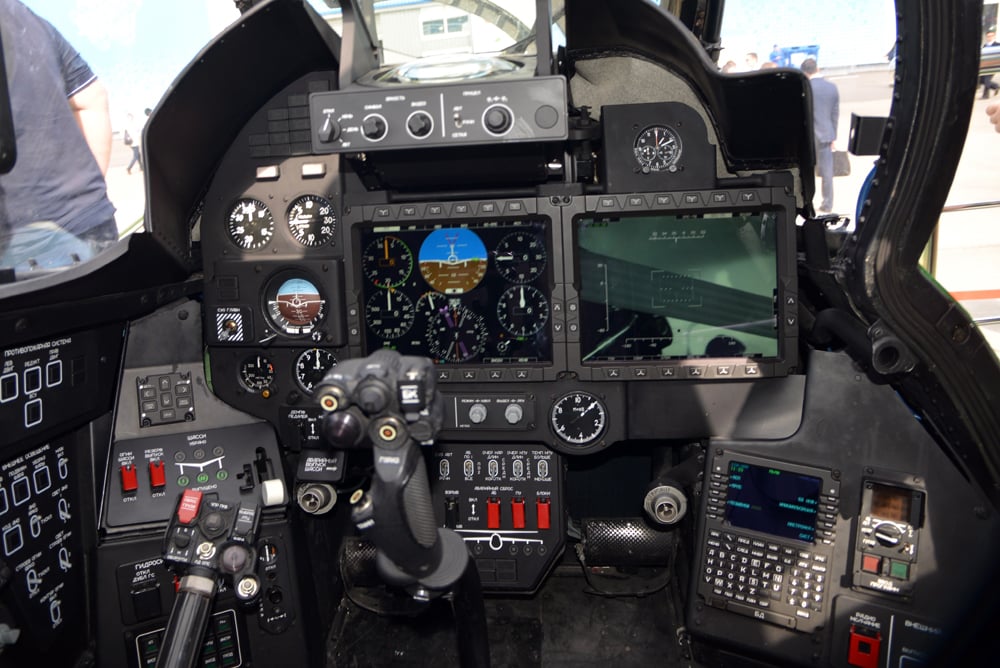Click Here to View This Page on Production Frontend
Click Here to Export Node Content
Click Here to View Printer-Friendly Version (Raw Backend)
Note: front-end display has links to styled print versions.
Content Node ID: 398796
Ongoing modernization efforts for the Mil Mi-24P—first delivered in 1975—are aimed at increasing the attack helicopter’s lethality and improving its survivability over the modern battlefield. At MAKS 2019, the KRET avionics merger exhibited the Mi-24P-1M upgrade, produced from an in-service example by replacing the avionics and mission equipment and adding modern air-launched munitions.
According to a written statement from KRET’s parent Rostec corporation, the modified Mi-24P features a modern flight-control and navigation system that is common with other helicopter types, an electro-optical system for search and targeting, optional active-array radar, all-axis autopilot, a self-protection suite, and a reworked power supply. It further states that the helicopter’s empty weight is reduced by 430 kg (948 pounds) through the replacement of old and heavy equipment with more recent items. The all-up weight remains at 11,500 kg (25,353 pounds), while payload inside the cabin rises to 1,500 kg (3,306 pounds), and on outer pylons to 2,400 kg (5,290 pounds).
“The Mi-24P-1M, a recent modernization of the long-serving helicopter, is developed by Russian Helicopters and KRET to have higher technical and combat performance, thus making the machine more attractive to our customers,” said Anatoly Serdyukov, director of Rostec’s aviation cluster.
New mission computers are installed, and both forward and rear cockpits are reworked with large color liquid crystal displays, and wide-angle, head-up displays developed for the combat-proven Mi-28NM and Ka-52. Outwardly, the modified example differs in having additional electro-optics, including a modern multi-spectral warning and threat analysis system under the helicopter’s belly. After detecting an incoming projectile, the system autonomously analyses the nature of the threat to determine its characteristics, before commanding appropriate jamming and launching decoys.

The Mi-24P-1M cannot use the legacy 9M114 supersonic missiles, the primary anti-tank weapon for the factory-standard helicopters, because of the removal of the radio command guidance equipment associated with the Mi-24P’s Shkval-V fire-control system. Instead, it employs laser-guided derivatives of the more recent 9M120 Ataka series from the same developer, KBP.
To strike targets at ranges greater than six km (3.24 nm), the helicopter’s arsenal is extended with an air-launched version of the 9M123 missile developed for the 9K123 Khrizantema all-weather, anti-tank system on a tracked chassis. With a reported range of up to 15 km (eight nm], the 9M123 requires the Mi-24P-M1 to carry a radar pod for target detection and engagement, as on the improved Mi-28NM demonstrated at the Army 2019 show. Alternatively, the radar’s active array can be placed in the fuselage forward section just below the front cockpit, as on the airframe on display at MAKS.
The radar can also be used to find, locate, and track aerial threats and engage them with the 9M340 Sosna-R laser-guided missile. The Mi-24P-M1 carries an air-launched version of the baseline weapon developed for the Sosna short-range SAM system on a tracked chassis and its naval derivative, the Palma, both of which are already in service.